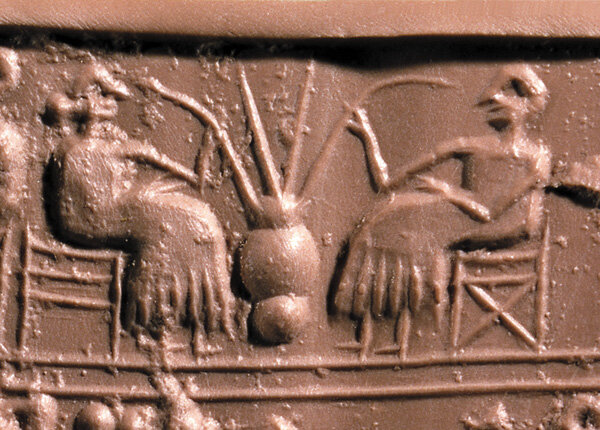History of merchants, beer in Ancient Mesopotamia
This Babylonian cylinder seal from Ur (c. 2600 B.C.E.) shows two people drinking beer out of a jar using straws.
By Weam Namou
The Chaldean Cultural Center has five galleries to stroll through: Chaldeans in the Ancient World, Faith & Church, Village Life, Journey to America, and Chaldeans Today. Journey to America, which has a threshold date of 1933, is based on the fact that the pioneer Chaldeans already owned grocery stores in Detroit by 1933.
Most of the early pioneers who came to America were men from the villages seeking better economic opportunities and for adventure. They learned the grocery store business from Syrian and Lebanese friends and established themselves in that trade. But historically, Chaldean merchants had been trading in Mesopotamia for thousands of years. The Sumerians used a barter system to buy and sell goods. They exchanged their goods and services for other goods and services that they needed.
The Babylonians were the first people to use Shekels, which was a silver, gold, or copper coin.
This cuneiform (3100 to 3500 BC) records beer given to workers as part of their daily rations.
Our knowledge of merchants in ancient Babylon comes from the famous “Code of Hammurabi,” a set of 282 laws that governed Mesopotamian society. Nearly a tenth of the Code covers laws of business and economics, including arranging out the duties and responsibilities of the merchant class. Merchants were given a high level of protection by Hammurabi’s laws. They also controlled the banking system of Babylonia.
As for operating liquor stores in particular, Chaldeans were doing that long before they came to America. In ancient times, alcohol, used in moderation, was seen as an important medicinal ingredient and as an essential part of the diet. It is the origin of the most famous toast, “Let’s drink to health,” which exists in many languages around the world.
Beer was a staple in Mesopotamians’ diet and a favorite drink from prehistoric times. It was the most popular drink for men, women, and children alike. Started and cultivated by women, brewing beer began in the small village of Godi Tepe, which later became an important town and fortress along the famous Silk Road trade route. Ebla, another Sumerian outpost, brewed great quantities of beer using different recipes. These earliest beers were possibly concocted with the aid of barley that was extracted from bread. The fermentation method apparent in grains, which may have been left out unattended, could have motivated the creation of both wine and beer.
Because Mesopotamians boiled fresh water to make beer, killing bacteria and waterborne disease, it was a healthier and maybe even tastier drink than water from canals, which could be contaminated by animal waste. And it had nutrients other beverages did not. The varieties of beer were endless, brewed to different strengths and with different flavors. Although beer was cautiously filtered, it was drunk through a straw, which Sumerians invented specifically to keep from consuming residue in the beer.
Women initially brewed beer in the home until commercial production of the beverage began and men started taking over. Ninkasi, the goddess of beer, symbolized the role women played in brewing and preparing beverages in ancient Mesopotamia. Beer was offered to the gods and goddesses and to the dead during drink rituals. In the poem Inanna and the God of Wisdom, the goddess Inanna and the god of wisdom Enki get drunk together before Inanna requests of him to give her the powerful essentials she needs for her city. In the poem Enki and Ninmah, the goddess Ninhursag loses respect when Enki defeats her in a drinking game. The drinker showed signs of weakness when he or she weren’t able to hold their drink. But in Mesopotamia, people from all ranks drank beer. Employers provided workers with daily rations of it.
The late Mary Dabish provided us with this picture of her father Sam Dabish in front of a display of Pepsi at his store Dabish Market after it was remodeled in 1950. It was at 8517 Second Ave. & Philadelphia St. in Detroit. Salman Dabish, Mary's husband, is standing behind the display.
Beer consumption was an important marker for societal and civilized virtues, created to make the heart feel light. Beer was considered to have healing and uplifting elements which could advance one’s life. In the Epic of Gilgamesh, the wild man Enkidu “did not know how to eat bread nor had he ever learned to drink beer!” with the latter phrase suggesting that drinking beer was seen as a “quality” of a civilized person.
Ninkasi and beer were associated with healing. She made fresh beer every day, using the best ingredients. Her priestesses sang a hymn to her as they worked. The hymn doubles as a praise song and instructions for how to brew beer. Few people were literate during that time, and the Hymn to Ninkasi allowed an easy way to remember the recipe which was passed down by master brewers to their apprentices. According to the hymn, the pouring of the beer is “like the onrush of the Tigris and Euphrates.” Like those two rivers, beer brought life to those who drank it.



